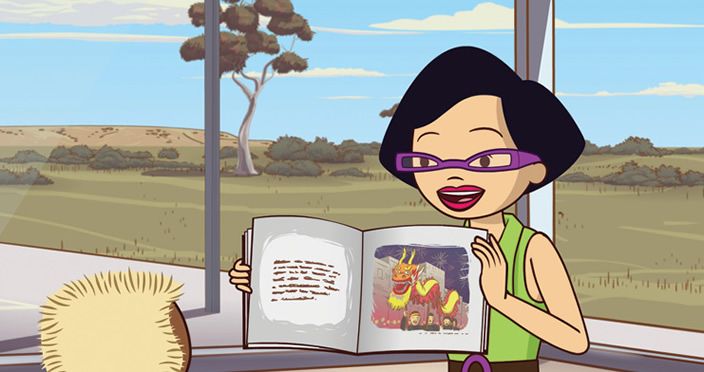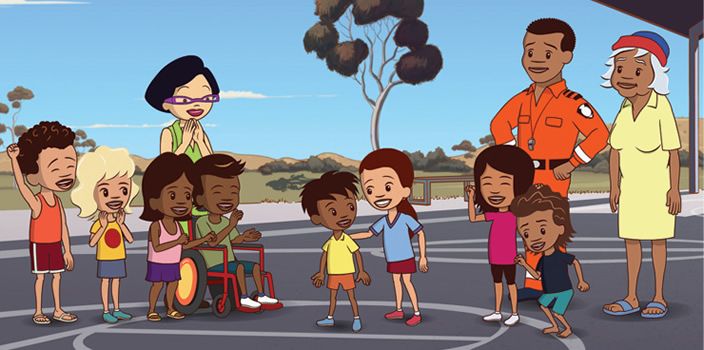What’s the series about?
The series highlights kinship relationships in First Nations communities, preservation of nature, storytelling and teaching, among other lessons rooted in Indigenous knowledge and practice.
With an all Indigenous cast and writing staff, as well as a team of Indigenous educators to develop the accompanying educational resources, Little J & Big Cuz captures authentic Aboriginal and Torres Strait Islander stories, experiences, teachings and voices.
Following the lives of a young boy– Little J – and his cousin – Big Cuz – audiences watch the pair and their peers explore the world of learning, inside and outside the formal school curriculum.
Drawing on lessons from Nanna and community members, the children are guided to learn more about themselves, and more about Country. The children are then able to share this knowledge with their classmates, and their teacher Ms Chen.
Creating Little J & Big Cuz
Little J & Big Cuz is a joint project of the Australian Council for Educational Research (ACER), Ned Lander Media, NITV, Screen Australia, Film Victoria, Screen Tasmania, the Australian Children’s Television Foundation and SNAICC – National Voice for our Children.
ACER Foundation Director Lisa Norris said it was envisioned for the creative drive of the project to come from Indigenous writers, directors and educators.
“It would be wrong to have it any other way.
“After all, it is their stories, culture and experiences that we are seeing reflected in Little J & Big Cuz.”
Teacher and Indigenous Education Consultant Priscilla Reid-Loynes, along with a team of education professionals Elizabeth Barret Jackson, Dr Sue Atkinson, and Alison Wunungmurra reviewed the scripts and provided feedback that informed the development of the complementary educational resources.
“When Priscilla came on board with ACER we really began to understand what the overall project, and what the resources might look like,” Norris said.
“Our brilliant education team drove all the content you see in the resources.”
In the classroom
Foregrounded in the series is the concept that Elders, families and children are knowledge holders.
Engaging with Indigenous communities to hear their stories of Country and of their experiences fosters a sense of understanding for any ECE or school community.
Little J & Big Cuz’s classroom models ways knowledge can be shared from children and families in educational settings.
“There is so much these students bring to a classroom if they have the confidence to share it,” Norris said.
The resources have been designed to provide a starting point for teachers to engage children in the program’s themes, but ultimately allow educators to create their own way of blending western and Indigenous knowledge that suits their school and their classroom.
The learning documents for each episode are a springboard for engaging with, and embedding, Indigenous perspectives and pedagogies in early childhood education environments by modelling and encouraging:
- embracing Indigenous knowledge and culture and how these can build on current understandings and create new learning opportunities with children, families and community
- engagement with local and broader Aboriginal and/or Torres Strait Islander communities to learn from and with their communities, and to build authentic relationships
- fostering of language that shares and respects the voices of Indigenous peoples, their knowledge and their cultures
- considerations of the educational and learning transitions that take place in children’s lives, and educators’ roles in working with children and families to support them during these times, and
- consideration of indoor and outdoor environments and associated Indigenous knowledge of these spaces.
Watch and learn
From the first episode of the series, we see how it brings audiences along with Little J & Big Cuz as they learn from their community and their Country, and incorporate this knowledge into their school experience.
In episode one, season one, Little J participates in a game of basketball with ‘the big kids’, with a new found sense of confidence thanks to his pair of ‘lucky’ underwear. He also helps his friend present a science experiment to the class that was prepared at home.
This highlights the experiences of outdoor play and indoor play that make up the curriculum.
This episode in particular highlights programmatic elements integral to high quality transition programs, including: a broad focus on child development that prioritises capacity to learn over specific knowledge; targeted approaches to building children’s familiarity and relationships with school; and family engagement and involvement throughout the school transition process.
The episode also incorporates a number of key messages rooted in Indigenous culture and knowledge, including:
- elders, families, friends and children are important in caring for themselves and each other
- elders, families and children are knowledge holders
- classrooms can be indoor environments, and outdoor on Country
- being out in Country is good for wellbeing
- things can be designed and made by re-using what children have at home
- using imagination is important, and
- Indigenous languages and communities are unique and diverse.
All episodes of Little J & Big Cuz have Indigenous knowledge embedded in their stories, and each episode’s
resource pack can help early childhood education staff guide children through learning from these stories.
To access all episodes and complementary resources for early childhood education, visit www.littlejandbigcuz.com.au




































































































































